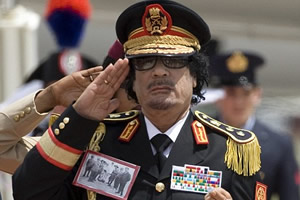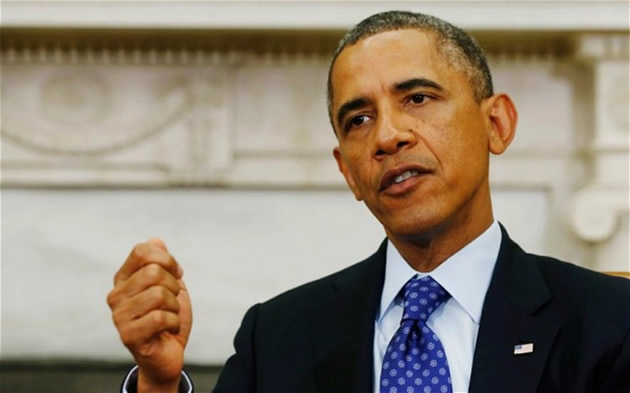The dreadful chronology of Gaddafi’s murder

Chris Welzenbach Correspondent
Jean-Paul Pougala’s April 14, 2011 piece in Pambazuka News titled “The Lies Behind the West’s War on Libya” describes how Africa first developed its own transcontinental communications system by purchasing a telecommunications satellite on December 26, 2007: the African Development Bank ponied up $50 million toward the nearly $400 million cost of the orbiter and the West African Development Bank added $27 million more.
Libya contributed $300 million, which made the purchase possible. Pougala writes that when it was up and running, the new system was “connecting the entire continent by telephone, television, radio broadcasting and several other technological applications such as telemedicine and distance teaching.”
After 14 years of foot-dragging by the IMF and the World Bank, Libyan leader Muammar Gaddafi’s generosity allowed for this one-time purchase that spared the nations of Africa a $500 million annual lease payment for access to a telecom satellite and euchred Western banks out of potential billions in loans and interest.
At this time, Gaddafi was also seeking to establish a trans-African banking system based on gold to free the continent from its financial bondage to the IMF and the World Bank — which would gravely harm both predatory entities. Since 2003, Gaddafi had worked hard to repair his reputation for financing terrorism by renouncing any future support for terrorist organisations and by establishing a fund to compensate victims of Pan Am Flight 103 and UTA Flight 772, each destroyed by acts of terror believed to have been financed by Libya.
On December 10, 2007 Gaddafi travelled to France for a pow-wow with then-President Nicolas Sarkozy.
During their December 11, 2007 meeting at the Elysee Palace, Gaddafi and Sarkozy signed some $15 billion worth of contracts for military hardware and a nuclear power station, but matters other than trade were also on the agenda.
In a March 12, 2012 report, the French investigative journalism consortium Mediapart stated: “According to information contained in a confidential report prepared by a recognised French expert on terrorism and terrorist financing, President Nicolas Sarkozy’s 2007 election campaign received up to 50 million euros in secret funds from the regime of the late Libyan dictator Colonel Muammar Gaddafi.”
Documents released by Mediapart on September 11, 2016 confirm that the financial relationship between Gaddafi and Sarkozy dates back to December 10, 2006.
(Upon the initial release of this information in 2012, Sarkozy denied he’d accepted Libyan money to finance his campaign — which is illegal in France and could well land him in prison — and attempted to sue Mediapart. However, an official investigation was launched into Sarkozy’s conduct and when portions of the resulting secret report surfaced at Mediapart’s website, the evidence pointed squarely to Sarkozy’s receipt of Gaddafi’s cash).
Gaddafi recognised that because of his telecom satellite initiative and his as yet unpublicised Pan-African banking proposal (which no doubt the West was well aware of), his popularity with Western leaders was slipping and that he might soon be the target of “regime change” and likely hoped that by financing Sarkozy’s election, he was buying insurance against his own untimely death.
Meanwhile, he did his best to be seen as a good pro-West statesman. In August 2008, Gaddafi signed agreements with the US, formalising compensation for victims of state terror and in September 2008, Condoleezza Rice visited Libya and declared that relations between the two nations had entered a “new phase”.
But in February 2009, Gaddafi was elected Chairman of the African Union and first made public mention of a “United States of Africa” and hinted at the possibility of a pan-African banking system. (Ominously, on March 12, 2009 Sarkozy made France part of Nato, breaking with a tradition that went back to de Gaulle.) Then, in August of 2009, Abdelbaset Ali al-Megrahi — convicted of participating in the Pan Am Flight 103 bombing — was released from prison in Scotland and given a hero’s welcome upon his return to Libya and later that same year Libya inked a deal with Russia to purchase $1,8 billion in weapons. These developments did not enhance Gaddafi’s profile in Western eyes.
Also, there was a lot of money at stake. Prior to the fall of Gaddafi, oil-rich Libya had cash reserves of $150 billion and there were 143 tonnes of gold in Gaddafi’s vaults. As Pougala wrote in his Pambazuka News piece: “(A large portion of this money) had been earmarked as the Libyan contribution to three key projects which would add the finishing touches to the African federation — the African Investment Bank in Syrte, Libya, the establishment in 2011 of the African Monetary Fund and the Abuja-based African Central Bank in Nigeria, which when it starts printing African money, will ring the death knell for the CFA franc through which Paris has been able to maintain its hold on some African countries for the last 50 years.”
In a June 7, 2016 posting at Black Opinion, Bob Fitrakis wrote: The real reasons for the attack have been dealt with most directly by America’s most famous reformed economic hitman, John Perkins.
Perkins points out that the attack on Libya, like the attack on Iraq, has to do with power and control of resources, not only oil, but gold. Libya has the highest standard of living in Africa.
According to the IMF, Libya’s Central Bank is 100 percent state owned. The IMF estimates that the bank has nearly 144 tonnes of gold in its vaults, Perkins wrote.
Nato went there like modern Barbary Coast Pirates to loot Libya’s gold. The Russian media, in addition to Perkins, reported that the Pan-Africanist Gaddafi, the former president of the African Union, had been advocating that Africa use the gold so plentiful in Libya and South Africa to create an African currency based on a gold dinar.
It is significant that in the months running up to the UN resolution that allowed the US and its allies to send troops into Libya, Muammar al-Gaddafi was openly advocating the creation of a new currency that would rival the dollar and the euro.
In fact, he called upon African and Muslim nations to join an alliance that would make this new currency, the gold dinar, their primary form of money and foreign exchange. They would sell oil and other resources to the US and the rest of the world only for gold dinars, Perkins explained.
In December 2010, a revolution in Tunisia brought down the Tunisian government. Subsequently, in January 2011 came a series of events hailed in the Western press as the “Arab Spring”: civil uprisings in Oman, Yemen, Egypt, Syria and Morocco. While these uprisings led to substantive change in Tunisia, they were brutally suppressed in Egypt and led to civil wars in Syria and Yemen that still rage. Those in Oman and Morocco fizzled out.
In Libya things broke funny. Starting on February 15, 2011, a series of protests demanding Gaddafi’s ouster erupted across Libya. By February 20, 2011 it was reported that some 300 civilians had been killed in the resulting violence, and that Gaddafi had launched warplanes against opposition groups in Tripoli.










Comments